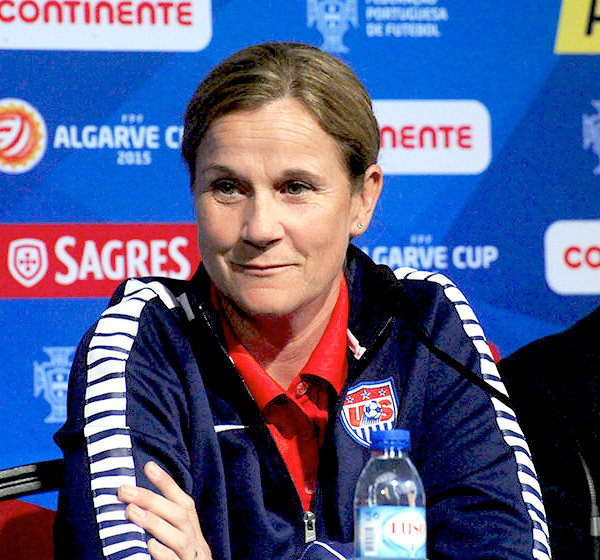During the Group Stage of the 2015 women’s World Cup, I researched and wrote a series of posts about each of the coaches of the women’s national soccer teams taking part in the competition. The stories I found were fantastically interesting. The range in experience, age, and attitude among the coaches was far wider than I had expected. Those posts can be found organized by group:
- Group A – Canada, China, the Netherlands, New Zealand
- Group B – Germany, Ivory Coast, Norway, Thailand
- Group C – Cameroon, Ecuador, Japan, Switzerland
- Group D – Australia, Nigeria, Sweden, the United States
- Group E – Brazil, Costa Rica, Korea, Spain
- Group F – Colombia, England, France, Mexico
With stories comes information and as I gathered information about the coaches, I threw it in a table to create data. I was curious not just about qualitative information about the coaches, who were they, what were their backgrounds, proclivities, etc., but also about who they were, quantitatively, as a group? Were they old? Young? Male? Female? From the country they were coaching? Or hired guns? Had they played soccer when they were younger? Professionally or internationally? How good were they? I found a lot that was interesting. Here are some of the highlights.
- Two thirds of the coaches are men. This raw fact can be interpreted in many ways. This could be seen as a good thing. As global sports cultures begin to take women’s sports more seriously, coaching a women’s national team has become a much more desirable job. And, although it’s unfortunate that men are still more able to get desirable jobs in coaching than women, the current imbalance is an overall positive signal about women’s sports. On the other hand, it could be seen as a bad thing. You could interpret the ratio of men to woman coaches as being an expression of paternalism — “it’s very nice (of us men) to let women play and even give them a knowledgeable coach (man) to lead them.”
In reality, both interpretations are true. The Spanish and Nigerian coaches strike me as being symbolic of everything that’s wrong with men coaching women’s sports. The Spanish coach has been in charge forever, seems to have no pressure to win, and his players don’t like him. The Nigerian coach seems to have been a political choice with no real coaching talent. On the flip side, the Mexican and English coaches are also male but seem to have been put in charge for the right reasons and be doing a good job. The Mexican coach, like the Spanish coach has been around forever, but under his watch the team uses the same facilities as the men’s national team and has improved wildly. The English coach is a standard, fast-rising, up and coming coach who could easily be coaching a top-flight professional men’s team. He’s qualified and driven.
Of the 16 countries who advanced to the knockout round, 75% of them are male. That’s up slightly from the 66% of overall competitors who were coached by men. It means that male coaches did slightly better than female coaches. We’re working with such small numbers, that the difference between 75% and 66% is only around 1.5 teams/coaches. I’m willing to throw that deviation out and guess that there was no real difference in how well teams coached by men and women did. - Age helps but only a little. The average age of coaches was 47. The male coaches were slightly older, with an average age of 49 as opposed to 43 from the women. There were a few coaches on the edges of the age range worth noting. Of the four coaches in their 60s, all four were male: Leonardo Cuéllar, Philippe Bergeroo, Ignacio Quereda, and Even Pellerud. There were only two coaches in their 20s, both women from Spanish speaking countries: Amelia Valverde from Costa Rica and Vanessa Arauz from Ecuador. The average age of coaches who advanced to the knockout round was 48 and the average age of those who failed to advance was 44.
- Most coaches have played professional or international soccer, but the female coaches are much more likely to have been good to great. Of all the coaches we have information about, almost 60% of them played some professional soccer and 36% of them played internationally. A smaller percentage were either solid players or great players in their day: 45% professionally and 27% internationally. What jumps out about these numbers though is the split between men and women. One half of all the women coaching played professionally and internationally and of those, 75% can be said to have been truly brilliant players. Two of them were actually teammates, Silvia Neid and the Swiss coach, Martina Voss-Tecklenburg, who both played for Germany. Of the men, only 40% were solid professional players and 13% solid international players. None were brilliant international level players.
- Some coaches are hard to research. A handful of the coaches were very difficult to find information about. Some don’t have Wikipedia pages, some have pages with very little information on them. I had to go digging to figure out even basic things about many of the coaches, like previous jobs, whether they had playing careers, and what their stories were. For two coaches, Nuengruethai Sathongwien of Thailand and Edwin Okon of Nigeria, I eventually gave up. I’m not sharing this to complain, but because it’s pretty stunning that information about the coach of a team going to the World Cup finals would be difficult to find. This would be inconceivable in the men’s game, which is obsessed over and covered at a minute level.
View the data in Google docs, here.

